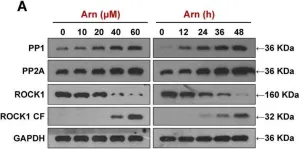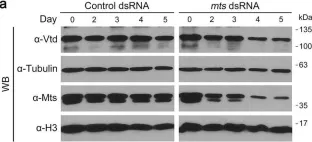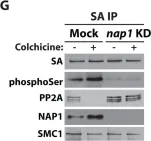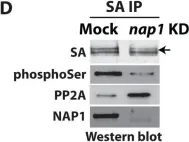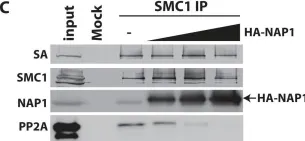In animals, mitosis involves the breakdown of the nucleus. The reassembly of a nucleus after mitosis requires the reformation of the nuclear envelope around a single mass of chromosomes. This process requires Ankle2 (also known as LEM4 in humans) which interacts with PP2A and promotes the function of the Barrier-to-Autointegration Factor (BAF). Upon dephosphorylation, BAF dimers cross-bridge chromosomes and bind lamins and transmembrane proteins of the reassembling nuclear envelope. How Ankle2 functions in mitosis is incompletely understood. Using a combination of approaches in Drosophila, along with structural modeling, we provide several lines of evidence that suggest that Ankle2 is a regulatory subunit of PP2A, explaining how it promotes BAF dephosphorylation. In addition, we discovered that Ankle2 interacts with the endoplasmic reticulum protein Vap33, which is required for Ankle2 localization at the reassembling nuclear envelope during telophase. We identified the interaction sites of PP2A and Vap33 on Ankle2. Through genetic rescue experiments, we show that the Ankle2/PP2A interaction is essential for the function of Ankle2 in nuclear reassembly and that the Ankle2/Vap33 interaction also promotes this process. Our study sheds light on the molecular mechanisms of post-mitotic nuclear reassembly and suggests that the endoplasmic reticulum is not merely a source of membranes in the process, but also provides localized enzymatic activity.
© 2024, Li et al.
Product Citations: 47
Mechanisms of PP2A-Ankle2 dependent nuclear reassembly after mitosis.
In eLife on 18 February 2025 by Li, J., Wang, X., et al.
-
Cell Biology
Mechanisms of PP2A-Ankle2 dependent nuclear reassembly after mitosis
Preprint on BioRxiv : the Preprint Server for Biology on 7 October 2024 by Li, J., Wang, X., et al.
In animals, mitosis involves the breakdown of the nucleus. The reassembly of a nucleus after mitosis requires the reformation of the nuclear envelope around a single mass of chromosomes. This process requires Ankle2 which interacts with PP2A and promotes the function of Barrier-to-Autointegration Factor (BAF). Upon dephosphorylation, BAF dimers cross-bridge chromosomes and bind lamins and transmembrane proteins of the reassembling nuclear envelope. How Ankle2 functions in mitosis is incompletely understood. Using a combination of approaches in Drosophila, along with structural modeling, we show for the first time that Ankle2 is a regulatory subunit of PP2A, explaining how it promotes BAF dephosphorylation. In addition, we discovered that Ankle2 interacts with the endoplasmic reticulum protein Vap33, which is required for Ankle2 localization at the reassembling nuclear envelope during telophase. We identified the interaction sites of PP2A and Vap33 on Ankle2. Through genetic rescue experiments, we show that the Ankle2/PP2A interaction is essential for the function of Ankle2 in nuclear reassembly and that the Ankle2/Vap33 interaction also promotes this process. Our study sheds light on the molecular mechanisms of post-mitotic nuclear reassembly and suggests that the endoplasmic reticulum is not merely a source of membranes in the process, but also provides localized enzymatic activity.
-
Cell Biology
Diabetic Ketoacidosis Induces Tau Hyperphosphorylation in Rat Brain.
In Journal of Alzheimer's Disease Reports on 15 May 2024 by Basurto-Islas, G., Tung, Y. C., et al.
Diabetes mellitus (DM) increases the risk for cognitive impairment and Alzheimer's disease (AD). Diabetic ketoacidosis (DKA), a serious complication of DM, may also cause brain damage and further AD, but the underlying molecular mechanisms remain unclear.
Our objective was to understand how DKA can promote neurodegeneration in AD.
We induced DKA in rats through intraperitoneal injection of streptozotocin, followed by starvation for 48 hours and investigated AD-related brain alterations focusing on tau phosphorylation.
We found that DKA induced hyperphosphorylation of tau protein at multiple sites associated with AD. Studies of tau kinases and phosphatases suggest that the DKA-induced hyperphosphorylation of tau was mainly mediated through activation of c-Jun N-terminal kinase and downregulation of protein phosphatase 2A. Disruption of the mTOR-AKT (the mechanistic target of rapamycin-protein kinase B) signaling pathway and increased levels of synaptic proteins were also observed in the brains of rats with DKA.
These results shed some light on the mechanisms by which DKA may increase the risk for AD.
© 2024 – The authors. Published by IOS Press.
-
Rattus norvegicus (Rat)
In Nature Communications on 3 December 2022 by Ohe, S., Kubota, Y., et al.
Growth factor-induced, ERK-mediated induction of immediate-early genes (IEGs) is crucial for cell growth and tumorigenesis. Although IEG expression is mainly regulated at the level of transcription elongation by RNA polymerase-II (Pol-II) promoter-proximal pausing and its release, the role of ERK in this process remains unknown. Here, we identified negative elongation factor (NELF)-A as an ERK substrate. Upon growth factor stimulation, ERK phosphorylates NELF-A, which dissociates NELF from paused Pol-II at the promoter-proximal regions of IEGs, allowing Pol-II to resume elongation and produce full-length transcripts. Furthermore, we found that in cancer cells, PP2A efficiently dephosphorylates NELF-A, thereby preventing aberrant IEG expression induced by ERK-activating oncogenes. However, when PP2A inhibitor proteins are overexpressed, as is frequently observed in cancers, decreased PP2A activity combined with oncogene-mediated ERK activation conspire to induce NELF-A phosphorylation and IEG upregulation, resulting in tumor progression. Our data delineate previously unexplored roles of ERK and PP2A inhibitor proteins in carcinogenesis.
© 2022. The Author(s).
-
WB
-
Biochemistry and Molecular biology
-
Genetics
In The Journal of Biological Chemistry on 1 September 2022 by Glaser, D., Heinick, A., et al.
The activity of protein phosphatase 2A (PP2A) is determined by the expression and localization of the regulatory B-subunits. PP2A-B56α is the dominant isoform of the B'-family in the heart. Its role in regulating the cardiac response to β-adrenergic stimulation is not yet fully understood. We therefore generated mice deficient in B56α to test the functional cardiac effects in response to catecholamine administration versus corresponding WT mice. We found the decrease in basal PP2A activity in hearts of KO mice was accompanied by a counter-regulatory increase in the expression of B' subunits (β and γ) and higher phosphorylation of sarcoplasmic reticulum Ca2+ regulatory and myofilament proteins. The higher phosphorylation levels were associated with enhanced intraventricular pressure and relaxation in catheterized KO mice. In contrast, at the cellular level, we detected depressed Ca2+ transient and sarcomere shortening parameters in KO mice at basal conditions. Consistently, the peak amplitude of the L-type Ca2+ current was reduced and the inactivation kinetics of ICaL were prolonged in KO cardiomyocytes. However, we show β-adrenergic stimulation resulted in a comparable peak amplitude of Ca2+ transients and myocellular contraction between KO and WT cardiomyocytes. Therefore, we propose higher isoprenaline-induced Ca2+ spark frequencies might facilitate the normalized Ca2+ signaling in KO cardiomyocytes. In addition, the application of isoprenaline was associated with unchanged L-type Ca2+ current parameters between both groups. Our data suggest an important influence of PP2A-B56α on the regulation of Ca2+ signaling and contractility in response to β-adrenergic stimulation in the myocardium.
Copyright © 2022 The Authors. Published by Elsevier Inc. All rights reserved.
-
ICC-IF
-
Mus musculus (House mouse)
-
Biochemistry and Molecular biology
In Front Oncol on 12 July 2022 by Galiger, C., Dahlhaus, M., et al.
Fig.5.A

-
WB
-
Collected and cropped from Front Oncol by CiteAb, provided under a CC-BY license
Image 1 of 12
In J Exp Clin Cancer Res on 19 February 2020 by Hu, J., Zhang, H., et al.
Fig.7.A

-
WB
-
Collected and cropped from J Exp Clin Cancer Res by CiteAb, provided under a CC-BY license
Image 1 of 12
In Sci Rep on 20 May 2019 by Kim, L. H., Hong, S. T., et al.
Fig.5.A

-
WB
-
Drosophila melanogaster (Fruit fly)
Collected and cropped from Sci Rep by CiteAb, provided under a CC-BY license
Image 1 of 12
In PLoS One on 20 June 2014 by Okumura, T., Harada, K., et al.
Fig.4.A

-
WB
-
Collected and cropped from PLoS One by CiteAb, provided under a CC-BY license
Image 1 of 12
In PLoS Genet on 3 October 2013 by Moshkin, Y. M., Doyen, C. M., et al.
Fig.4.H

-
WB
-
Collected and cropped from PLoS Genet by CiteAb, provided under a CC-BY license
Image 1 of 12
In PLoS Genet on 3 October 2013 by Moshkin, Y. M., Doyen, C. M., et al.
Fig.4.E

-
WB
-
Collected and cropped from PLoS Genet by CiteAb, provided under a CC-BY license
Image 1 of 12
In PLoS Genet on 3 October 2013 by Moshkin, Y. M., Doyen, C. M., et al.
Fig.4.D

-
WB
-
Collected and cropped from PLoS Genet by CiteAb, provided under a CC-BY license
Image 1 of 12
In PLoS Genet on 3 October 2013 by Moshkin, Y. M., Doyen, C. M., et al.
Fig.5.B

-
WB
-
Collected and cropped from PLoS Genet by CiteAb, provided under a CC-BY license
Image 1 of 12
In PLoS Genet on 3 October 2013 by Moshkin, Y. M., Doyen, C. M., et al.
Fig.5.G

-
WB
-
Collected and cropped from PLoS Genet by CiteAb, provided under a CC-BY license
Image 1 of 12
In PLoS Genet on 3 October 2013 by Moshkin, Y. M., Doyen, C. M., et al.
Fig.5.D

-
WB
-
Collected and cropped from PLoS Genet by CiteAb, provided under a CC-BY license
Image 1 of 12
In PLoS Genet on 3 October 2013 by Moshkin, Y. M., Doyen, C. M., et al.
Fig.5.C

-
WB
-
Collected and cropped from PLoS Genet by CiteAb, provided under a CC-BY license
Image 1 of 12
In PLoS Genet on 3 October 2013 by Moshkin, Y. M., Doyen, C. M., et al.
Fig.5.H

-
WB
-
Collected and cropped from PLoS Genet by CiteAb, provided under a CC-BY license
Image 1 of 12

